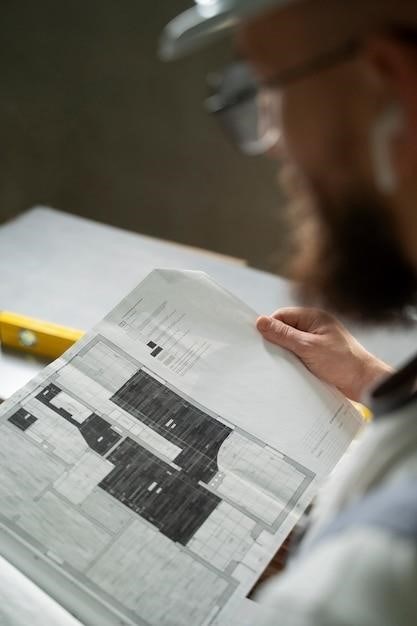Blueprint Reading⁚ A Comprehensive Guide
Blueprint reading is an essential skill for anyone working in the architecture‚ design‚ or construction industries. It is the ability to interpret technical drawings and understand the information they convey about a building or structure; This guide provides a comprehensive overview of blueprint reading‚ covering its importance‚ applications‚ types‚ elements‚ and interpretation. Whether you are a student‚ a professional‚ or a homeowner‚ this guide will equip you with the knowledge and skills to effectively read blueprints.
Introduction to Blueprint Reading
Blueprint reading is the ability to interpret technical drawings‚ known as blueprints‚ which represent the design and construction details of a building or structure. It is a fundamental skill for professionals in various fields‚ including architecture‚ engineering‚ construction‚ and manufacturing. Blueprints are essentially visual communication tools‚ providing a detailed roadmap for building or assembling a project. They convey information about dimensions‚ materials‚ specifications‚ and the arrangement of various components‚ enabling stakeholders to understand the intended design and execute it accurately.
Importance of Blueprint Reading
Blueprint reading is crucial for several reasons. Firstly‚ it ensures accurate construction by providing a clear visual representation of the design‚ eliminating ambiguity and reducing errors. Secondly‚ it facilitates efficient communication among professionals involved in the project‚ enabling them to work collaboratively and ensure everyone is on the same page. Thirdly‚ it helps in cost estimation and material procurement by providing detailed information on the required materials and quantities‚ optimizing the project budget. Finally‚ it aids in troubleshooting and maintenance by providing a reference point for identifying components‚ understanding their functions‚ and resolving any issues that may arise during the project lifecycle.
Applications of Blueprint Reading
Blueprint reading finds applications across various fields‚ extending beyond construction and engineering. Architects‚ designers‚ engineers‚ contractors‚ and even homeowners rely on blueprints for diverse purposes. In construction‚ they are essential for planning‚ building‚ and maintaining structures. Architects use them to create detailed plans for buildings and landscapes. Engineers utilize blueprints for designing and building complex systems like bridges‚ machines‚ and electrical circuits. Contractors use blueprints for bidding on projects‚ scheduling work‚ and managing materials. Homeowners can use blueprints for understanding their property‚ planning renovations‚ and troubleshooting maintenance issues.
Types of Blueprints
Blueprints are categorized based on their purpose and the specific information they convey. These categories include architectural‚ engineering‚ and mechanical blueprints.
Architectural Blueprints
Architectural blueprints‚ also known as architectural drawings‚ are the foundation of any construction project. They provide a detailed visual representation of a building’s layout‚ including its dimensions‚ materials‚ and structural components. These blueprints typically include floor plans‚ elevations‚ sections‚ and details. Floor plans show the arrangement of rooms‚ walls‚ and fixtures‚ while elevations depict the exterior facades of the building. Sections provide cross-sectional views‚ revealing the internal structure and construction methods. Details offer magnified views of specific elements‚ such as doors‚ windows‚ and stairs‚ ensuring accuracy and clarity in construction.
Engineering Blueprints
Engineering blueprints are specialized technical drawings that convey detailed information about the design‚ construction‚ and operation of various engineered systems and structures. These blueprints often incorporate complex symbols‚ notations‚ and technical specifications. They may include mechanical drawings‚ electrical diagrams‚ piping and instrumentation diagrams (P&IDs)‚ and structural plans. Mechanical drawings illustrate the components and assembly of machinery‚ while electrical diagrams depict the flow of electricity and the location of electrical components. Piping and instrumentation diagrams detail the flow of fluids and the instrumentation used to monitor and control processes. Structural plans show the design and support systems of bridges‚ buildings‚ and other structures.
Mechanical Blueprints
Mechanical blueprints are essential for the design‚ manufacturing‚ and assembly of machinery‚ equipment‚ and other mechanical systems. They provide detailed information about the components‚ dimensions‚ materials‚ and assembly processes involved in creating these items. These blueprints typically include orthogonal projections‚ sectional views‚ and detailed views of individual parts. Orthogonal projections show the object from multiple perspectives‚ while sectional views reveal the internal structure and features. Detail views provide magnified representations of specific parts‚ highlighting critical dimensions and features. Mechanical blueprints are crucial for ensuring accuracy‚ consistency‚ and proper functionality in the creation of mechanical systems.

Elements of a Blueprint
Blueprints are composed of various elements that work together to convey detailed information about a project. These elements include lines and symbols‚ dimensions and scales‚ and views and projections.
Lines and Symbols
Lines and symbols are the fundamental language of blueprints. They represent different features‚ materials‚ and dimensions. Understanding these lines and symbols is crucial for accurately interpreting blueprints. For instance‚ a solid line might indicate a visible edge‚ while a dashed line could represent a hidden edge. Circles‚ squares‚ and other geometric shapes can depict various components‚ such as doors‚ windows‚ or electrical outlets. Each symbol has a specific meaning‚ and familiarity with these symbols is essential for effective blueprint reading.
Dimensions and Scales
Dimensions and scales are critical elements of blueprints‚ providing precise measurements and proportions for the structure. Dimensions are numerical values indicating the length‚ width‚ and height of different components. They are typically represented in inches‚ feet‚ or meters. Scales‚ on the other hand‚ indicate the ratio between the blueprint’s measurements and the actual size of the structure. For example‚ a scale of 1⁚10 means that one inch on the blueprint represents ten inches in reality. Understanding dimensions and scales allows for accurate construction and ensures the building meets the intended design specifications.
Views and Projections
Blueprints often employ multiple views and projections to comprehensively represent the structure from different angles. Common views include the front view‚ side view‚ top view‚ and sectional views. These views provide a complete understanding of the building’s exterior and interior features. Projections‚ such as orthographic projections‚ use parallel lines to represent three-dimensional objects in two-dimensional space. Understanding these views and projections allows readers to visualize the structure’s form and spatial relationships between different elements. This is essential for accurate construction and ensuring the final product aligns with the intended design.
Interpreting Blueprint Information
Interpreting blueprints involves understanding the visual language of drawings‚ specifications‚ and symbols to extract essential information for construction and design.
Understanding Drawings
Blueprint drawings are like visual stories that depict a project’s design and construction details. Understanding these drawings requires familiarity with different types of views‚ such as plan views‚ elevations‚ sections‚ and details. Plan views show the layout of a space from above‚ elevations depict the exterior or interior walls‚ sections reveal the internal structure‚ and details provide close-up information about specific components. Each view plays a crucial role in conveying the overall design intent and construction requirements‚ making it essential to analyze them thoroughly for a comprehensive understanding of the project.
Reading Specifications
Blueprint reading involves more than just deciphering drawings; it also encompasses understanding the accompanying specifications. These written documents provide detailed information about materials‚ finishes‚ construction methods‚ and other project requirements. Specifications often complement the drawings by clarifying details that may not be explicitly shown‚ such as the type of paint to be used‚ the specific brand of fixtures‚ or the installation procedures for certain components. Carefully reading and interpreting specifications ensures adherence to project standards and avoids potential misunderstandings during construction.
Identifying Components
A crucial aspect of blueprint reading is the ability to identify and understand the various components depicted in the drawings. This involves recognizing symbols‚ labels‚ and annotations that represent different structural elements‚ fixtures‚ equipment‚ and systems. For instance‚ a blueprint might show the layout of walls‚ doors‚ windows‚ plumbing fixtures‚ electrical outlets‚ HVAC systems‚ and other essential components. Familiarizing yourself with common symbols and conventions used in blueprint reading will enable you to accurately identify and interpret the intended function and location of each component within the project.
Resources for Blueprint Reading
A wealth of resources exists to assist individuals in mastering the art of blueprint reading‚ from online courses and tutorials to specialized books and software applications. These resources provide valuable insights‚ practical exercises‚ and comprehensive guidance to enhance your understanding and proficiency.
Online Courses and Tutorials
The digital age has revolutionized learning‚ making blueprint reading accessible to anyone with an internet connection. Numerous online platforms offer comprehensive courses and tutorials‚ catering to various skill levels. These courses often feature interactive lessons‚ video demonstrations‚ and downloadable materials‚ providing a flexible and engaging learning experience. Platforms like Coursera‚ Udemy‚ and edX host courses taught by industry experts‚ covering topics from basic concepts to advanced applications. Online tutorials on websites like YouTube and Skillshare offer free or affordable access to step-by-step guidance‚ practical examples‚ and expert tips. These resources enable learners to acquire blueprint reading skills at their own pace‚ from the comfort of their homes.
Books and Textbooks
For those who prefer a more traditional learning approach‚ a vast selection of books and textbooks dedicated to blueprint reading is available. These resources provide detailed explanations of blueprint elements‚ symbols‚ and conventions‚ along with practical exercises and real-world examples. Some popular titles include “Blueprint Reading Basics” by Warren Hammer‚ “Blueprint Reading and Technical Sketching for Industry” by Thomas P. Olivo‚ and “Blueprint Reading for the Building Trades” by John E. Traister. These books offer a comprehensive understanding of blueprint reading principles and techniques‚ making them valuable resources for students‚ professionals‚ and anyone seeking to enhance their knowledge in this field.
Software Applications
In today’s digital age‚ software applications have revolutionized blueprint reading. Several programs are specifically designed to enhance the process‚ offering features like interactive viewing‚ annotation‚ and measurement tools. These applications allow users to zoom in on specific details‚ highlight important elements‚ and even create 3D models from 2D blueprints. Popular options include AutoCAD‚ Revit‚ and SketchUp‚ providing professionals and students with advanced tools for analyzing and manipulating blueprint data. These software solutions streamline the blueprint reading experience‚ facilitating a more efficient and interactive understanding of construction plans.

Tips for Effective Blueprint Reading
Mastering blueprint reading requires practice‚ patience‚ and a systematic approach. Start by familiarizing yourself with basic symbols and lines‚ then gradually work your way towards understanding complex drawings. Remember‚ practice makes perfect‚ and with consistent effort‚ you will develop a strong foundation in blueprint reading.
Practice Regularly
The key to becoming proficient in blueprint reading is consistent practice. Just like any skill‚ the more you practice‚ the better you will become at interpreting drawings and understanding their details. Set aside dedicated time for studying blueprints‚ and try to engage with them regularly. You can start with simple drawings and gradually move towards more complex ones. Practice reading different types of blueprints‚ such as architectural‚ mechanical‚ and electrical‚ to expand your understanding and enhance your overall skills.
Use Reference Materials
Blueprint reading can be challenging‚ especially when encountering unfamiliar symbols‚ abbreviations‚ or complex details. To overcome these hurdles‚ rely on reference materials that can provide clarity and guidance. Invest in comprehensive blueprint reading textbooks or online resources that offer definitions‚ explanations‚ and examples of various symbols‚ lines‚ and conventions used in blueprints. Utilize these resources to decipher unfamiliar elements and ensure accurate interpretation of the drawings.
Attend Workshops and Seminars
To enhance your blueprint reading skills and gain practical experience‚ consider attending workshops and seminars specifically designed for this purpose. These interactive sessions often provide hands-on practice‚ real-world examples‚ and expert guidance from experienced professionals. Workshops and seminars can cover a range of topics‚ from basic principles to advanced techniques‚ and provide opportunities to ask questions and receive personalized feedback. This immersive learning environment can significantly accelerate your understanding and proficiency in blueprint reading.
Mastering blueprint reading is a valuable asset in various fields‚ empowering individuals to effectively communicate‚ collaborate‚ and execute construction projects with precision and efficiency.
The Future of Blueprint Reading
The future of blueprint reading is intertwined with the evolution of technology. While traditional paper blueprints will likely remain relevant in certain sectors‚ digitalization is transforming the industry. Software applications and platforms like TXYZ are emerging as powerful tools for reading‚ annotating‚ and sharing blueprints. These digital tools offer advantages such as accessibility‚ collaboration‚ and advanced functionalities. Moreover‚ the integration of artificial intelligence (AI) is streamlining the process of interpreting complex drawings and extracting valuable information. As technology continues to advance‚ blueprint reading is poised to become more efficient‚ accessible‚ and insightful‚ empowering professionals across various fields to navigate the complexities of construction and engineering with greater ease and precision.
Blueprint Reading in the Digital Age
The digital age has ushered in a transformative era for blueprint reading‚ making it more accessible‚ efficient‚ and collaborative. Gone are the days of bulky paper blueprints. Today‚ digital platforms and software applications like TXYZ allow professionals to view‚ annotate‚ and share blueprints seamlessly. This shift has revolutionized the way blueprints are used‚ enabling faster communication‚ improved accuracy‚ and increased collaboration among stakeholders. Moreover‚ the rise of AI-powered tools is further enhancing the interpretation of complex drawings‚ extracting key information‚ and streamlining the design and construction process. With the increasing adoption of digital technologies‚ blueprint reading is evolving into a more dynamic and efficient practice‚ enabling greater accuracy and innovation across industries.
